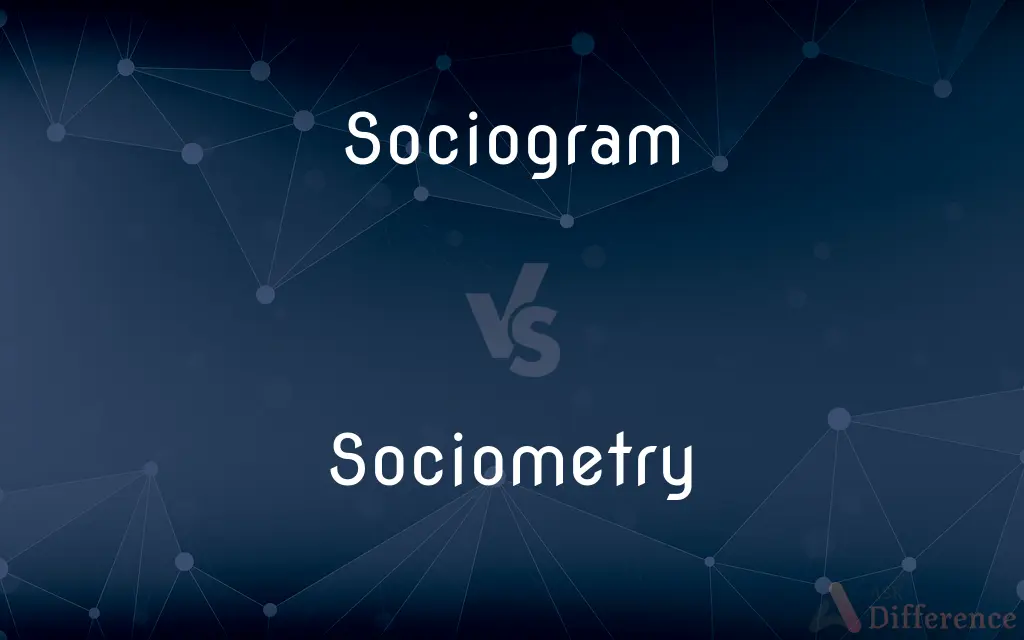Sociogram vs. Sociometry — What's the Difference?
Edited by Tayyaba Rehman — By Maham Liaqat — Updated on March 14, 2024
A sociogram visually maps relationships within a group, focusing on individual connections, while sociometry quantifies these relationships, measuring group dynamics through data.

Difference Between Sociogram and Sociometry
Table of Contents
ADVERTISEMENT
Key Differences
A sociogram is a graphical representation that shows the relationships among individuals within a group. It highlights how individuals are connected, illustrating friendships, social interactions, or communication patterns. On the other hand, sociometry takes a more quantitative approach, utilizing surveys, scales, and statistical methods to measure and analyze the relationships and structures within a group.
Sociograms make it easier to visually identify key players, outliers, and subgroups within a social setting by depicting connections with lines or symbols. Whereas sociometry provides numerical data that can offer insights into the intensity, frequency, and nature of these relationships, facilitating a deeper understanding of group dynamics.
In creating a sociogram, one focuses on the visual layout, using dots to represent individuals and lines to indicate relationships, which can be labeled to show different types of interactions. Sociometry, however, involves collecting data through direct questioning or observation and then applying mathematical models to interpret the social structure.
Sociograms are particularly useful in educational and therapeutic settings for identifying social connections and potential issues among group members. In contrast, sociometry can be applied in a broader range of fields, including sociology, psychology, and organizational management, to improve group interaction and cohesion.
While a sociogram provides a snapshot of social interactions at a specific point in time, sociometry enables the tracking of changes in relationships over time, offering insights into the dynamics of group development and the effects of interventions.
ADVERTISEMENT
Comparison Chart
Definition
A visual representation of social links within a group.
A method to measure and analyze social relationships.
Focus
Visualization of individual connections.
Quantitative measurement of group dynamics.
Tools Used
Graphs, symbols, and lines.
Surveys, scales, and statistical analysis.
Application Area
Education, therapy.
Sociology, psychology, organizational management.
Outcome
Visual map highlighting social patterns.
Numerical data providing insights into social structures.
Compare with Definitions
Sociogram
A method to depict the flow of communication or relationships in a network.
The sociogram of the project team showed a central figure through whom most communications passed.
Sociometry
Tracks changes in social relationships over time.
Through sociometry, changes in student interactions were monitored throughout the school year.
Sociogram
A diagram that represents the social relationships among a group of people.
In the classroom sociogram, lines connecting students illustrated who considered whom a friend.
Sociometry
Utilizes surveys and statistical methods to analyze social structures.
The researcher used sociometry to study workplace dynamics and employee satisfaction.
Sociogram
A tool to visually identify social dynamics and cliques within a group.
The therapist used a sociogram to detect isolation among group therapy participants.
Sociometry
Offers insights into the effectiveness of group interactions and interventions.
Post-intervention sociometry showed improved cohesion within the team.
Sociogram
Useful for highlighting social connections and potential issues in social settings.
The school counselor created a sociogram to understand peer relationships among students.
Sociometry
Can identify group leaders, isolates, and subgroups through data analysis.
Sociometry helped identify the informal leader who influenced team morale the most.
Sociogram
It uses visual symbols to represent people and the nature of their connections.
In the sociogram, dashed lines indicated weak relationships, while solid lines represented strong ties.
Sociometry
A quantitative approach to measure social relationships within a group.
Sociometry revealed the most preferred and least preferred members of the class.
Sociogram
A sociogram is a graphic representation of social links that a person has. It is a graph drawing that plots the structure of interpersonal relations in a group situation.
Sociometry
Sociometry is a qualitative method for measuring social relationships. It was developed by psychotherapist Jacob L. Moreno and Helen Hall Jennings in their studies of the relationship between social structures and psychological well-being, and used during Remedial Teaching.
Sociogram
A graphic representation of the structure of interpersonal relations in a group situation; a depiction of the social links that a person has.
Sociometry
The quantitative study of interpersonal relationships in populations, especially the study and measurement of preferences.
Sociometry
The quantitative study of social interactions, and the measurement of preferences etc.
Sociometry
The quantitative study of social relationships
Common Curiosities
What is a sociogram?
A visual representation that maps out the social relationships within a group.
Can sociograms show the strength of relationships?
Yes, through different symbols or lines, sociograms can depict the strength and nature of social connections.
What are sociograms used for?
They're used to visually identify social dynamics, connections, and potential issues within groups.
Is a sociogram quantitative or qualitative?
A sociogram is primarily qualitative as it visually represents social connections.
How does sociometry differ from a sociogram?
Sociometry uses quantitative methods to analyze social relationships, whereas a sociogram provides a visual map of these connections.
Can sociometry track changes over time?
Yes, sociometry enables the tracking of changes in social relationships and group dynamics over time.
How can sociometry be applied?
It can be applied in research, organizational management, psychology, and sociology to analyze and improve group dynamics.
Are sociograms useful in education?
Yes, they are particularly useful in educational settings for understanding student relationships and social structures.
How is a sociogram created?
By plotting individuals as points or nodes and drawing lines between them to represent relationships.
What is the main goal of sociometry?
To measure and analyze the relationships and structures within a group to improve interaction and cohesion.
What kind of data does sociometry provide?
Sociometry provides numerical data that can offer insights into the intensity, frequency, and nature of social relationships.
What insights can sociometry provide?
It can reveal the underlying structure of a group, including leadership, popularity, isolation, and subgroup formation.
Who can benefit from using sociograms?
Teachers, therapists, team leaders, and researchers can benefit from using sociograms to understand group dynamics.
Can sociometry be used in therapy?
Yes, it can be used to assess and improve the dynamics of therapy groups or interpersonal relationships within therapeutic settings.
What tools are used in sociometry?
Surveys, scales, and statistical analysis are commonly used in sociometry.
Share Your Discovery

Previous Comparison
Marmoset vs. Tamarin
Next Comparison
Charlie vs. CharlesAuthor Spotlight
Written by
Maham LiaqatEdited by
Tayyaba RehmanTayyaba Rehman is a distinguished writer, currently serving as a primary contributor to askdifference.com. As a researcher in semantics and etymology, Tayyaba's passion for the complexity of languages and their distinctions has found a perfect home on the platform. Tayyaba delves into the intricacies of language, distinguishing between commonly confused words and phrases, thereby providing clarity for readers worldwide.














































